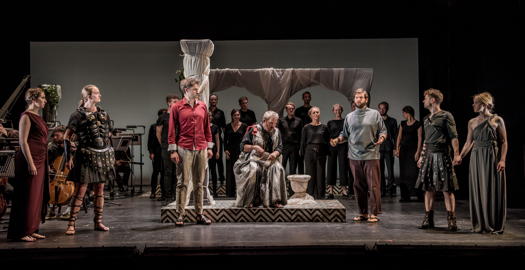- Jerrold Northrop Moore
- János Csányi
- Milan
- Wexford
- Fanny Hensel
- guitars
- New Year - New Sounds
- Ken Ueno: Ghost Flowers
An Irresistible Challenge
MIKE WHEELER listens to an operatic rarity -
'Lucio Papirio Dittatore' by Antonio Caldara
Operatic rarities don't come much rarer than Lucio Papirio Dittatore, by Antonio Caldara (1671-1736) - Buxton Festival, Buxton Opera House, Buxton UK, 9 July 2019. This appears to have been its first staging for three hundred years, a challenge director Mark Burns seems to have found irresistible. It meant being able to approach this latest project by baroque ensemble La Serenissima with no pre-conceptions, no performance traditions to take account of. As is his usual way of working, the group's music director, violinist Adrian Chandler, also started with a clean slate, producing an edition of the score from scratch.
Plotwise, we were in typical opera seria territory. Roman dictator Lucio Papirio has returned to Rome to consult the auguries concerning a forthcoming battle, leaving the army in the hands of Quinto Fabio, son of his advisor, Marco Fabio, with strict orders not to engage the enemy until he returns. But the enemy provokes a battle, which Quinto wins. Lucio is stung by jealousy into sentencing Quinto to death for his disobedience, while everyone around him pleads for mercy on Quinto's behalf. Matters are further complicated by the fact that Lucio's daughter, Papiria - one of a number of invented characters - is married to Quinto. As Lucio struggles to find a way forward, there are echoes of another classical ruler in a fix, Idomeneo - Mozart's opera was Buxton's headline production last year.
The orchestra was placed to one side of the stage, with Adrian Chandler leading, and harpsichordist Giulia Nuti directing the recitatives. The restricted acting area this left for the singers actually paid off in terms of focusing the production's energy. Against a plain backdrop, Kitty Callister's design placed a free-standing double archway, a ceremonial chair and pillars. These were wrapped in cloth, Callister taking her cue from artists Christo Javacheff and Jeanne-Claude Denat, who did the same with everything from small objects to large public buildings. It was an apt visual metaphor for the characters' perceived restrictions to their freedom of action. Costumes were simple and emblematic.

La Serenissima and the Buxton International Festival Chorus on stage for Lucio Papirio Dittatore. Photo © 2019 Genevieve Girling
Robert Murray humanised Lucio, with a mixture of resolution, bluster and inner conflict. Unusually, his aria at the end of Act I included interjections by other characters, emphasising the tensions between them.

Robert Murray as Lucio Papirio and Rowan Pierce as Papiria in Lucio Papirio Dittatore at the Buxton Festival. Photo © 2019 Genevieve Girling
The two counter-tenors were well contrasted vocally. The lighter-toned William Towers was a Marco almost as conflicted as Lucio himself. His Act III aria, in which he vents his grief and anger at the turn of events, was accompanied by Chandler in an obbligato of concerto-like virtuosity. The darker, almost contralto-like Owen Willets was suitably heroic and impetuous as Quinto, secure in runs in his Act I aria defending his actions to Lucio. For his pastoral-like aria at the start of Act III, he was joined by Louise Strickland, who stepped forward from the orchestra to play an expressive obbligato on a chalumeau, an early form of clarinet.

From left to right: Elizabeth Karani as Rutilia, Eleanor Dennis as Comminio, William Towers as Marco Fabio, Robert Murray as Lucio Papirio, Gareth Brynmor John as Servillio, Owen Willetts as Quinto Fabio and Rowan Pierce as Papiria in Lucio Papirio Dittatore at the Buxton Festival. Photo © 2019 Genevieve Girling
Rowan Pierce's Papiria showed a steely determination, heroically incisive in her big Act I aria. In Act III, as she and Quinto take what they expect to be their last farewell of each other, their duet was a moment of great tenderness. Elizabeth Karani was both sympathetic and wily as Papiria's friend Rutilia, in love with Eleanor Dennis' fiery officer Cominio. Gareth Brynmor John caught the ambivalence of Servilio, another of Lucio's functionaries, who eventually holds the key to resolving the situation - cue the final, typically sycophantic hymn of praise to Holy Roman Emperor Charles VI, for whose court the opera was written.
Will Caldara eventually join, say, Handel or Rameau on their baroque opera pedestals? This production argued his case forcefully.
Copyright © 24 July 2019
Mike Wheeler,
Derby UK





